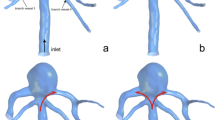Abstract
Background
Stent deployment across the aneurysmal neck has been established as one of the endovascular methods to treat intracranial aneurysms with or without coils.
Objective
The purpose is to study the possible adverse effects of deployment of the new flow-diverter stent-like devices (FD) on the flow characteristics of saccular aneurysm models.
Methods
Numerical simulations of the blood flow patterns in the artificial models of three aneurysms were studied. One model was designed without an FD stent, the second model with one FD stent, and the third model with two stents. Numerical simulation for incompressible laminar blood flow was conducted in the three artificial cerebral aneurysm models by means of computational fluid dynamics.
Results
There was a noticeable increase in the values of the circumferential pressure distributed on the walls of the aneurysm after stent deployment; this led to an increase the tension of the aneurysm surface and was considered to be an adverse effect. This pressure increase was further aggravated by the deployment of another stent. However, there is a beneficial effect of using FD stents, translating into the reduction of the flow velocity inside the aneurysm and wall shear stress at the inflow zone. This reduction decreases further with the deployment of another stent.
Conclusion
Aneurysms become tenser after the deployment of one flow-diverter stent and (more tense still) after after the deployment of another stent. This principle should be kept in mind when choosing which group of aneurysms is the best candidate for such a treatment strategy. This study recommends deploying several FD stents during endovascular procedures until complete arrest of the blood flow occurs during the procedure; otherwise, the aneurysm may become tenser and dangerous if a slow blood flow jet still exists inside it at the end of the procedure.






Similar content being viewed by others
References
Augsburger L, Farhat M, Reymond P, Fonck E, Kulcsar Z, Stergiopulos N, Rüfenacht DA (2009) Effect of flow diverter porosity on intraaneurysmal blood flow. Klin Neuroradiol 19:204–214
Cebral JR, Mut F, Raschi M, Scrivano E, Ceratto R, Lylyk P, Putman CM (2011) Aneurysm rupture following treatment with flow-diverting stents: computational hemodynamics analysis of treatment. AJNR Am J Neuroradiol 32(1):27–33
Doenitz C, Schebesch KM, Zoephel R, Brawanski A (2010) A mechanism for the rapid development of intracranial aneurysms: a case study. Neurosurgery 67:1213–1221
Ferns SP, Sprengers ME, van Rooij WJ, Rinkel GJ, van Rijn JC, Bipat S, Sluzewski M, Majoie CB (2009) Coiling of intracranial aneurysms: a systematic review on initial occlusion and reopening and retreatment rates. Stroke 40:e523–e529
Fiorella D, Albuquerque FC, Deshmukh VR, McDougall CG (2005) Usefulness of the Neuroform stent for the treatment of cerebral aneurysms: results at initial (3–6-mo) follow-up. Neurosurgery 56:1191–1201, discussion 1201–02
Fiorella D, Kelly ME, Albuquerque FC, Nelson PK (2009) Curative reconstruction of a giant midbasilar trunk aneurysm with the Pipeline embolization device. Neurosurgery 64:212–217, discussion 217
Fiorella D, Woo HH, Albuquerque FC, Nelson PK (2008) Definitive reconstruction of circumferential, fusiform intracranial aneurysms with the Pipeline embolization device. Neurosurgery 62:1115–1120, discussion 1120–21
Kulcsár Z, Houdart E, Bonafe A, Parker G, Millar J, Goddard AJ, Renowden S, Gál G, Turowski B, Mitchell K, Gray F, Rodriguez M, van den Berg R, Gruber A, Desal H, Wanke I, Rüfenacht DA (2011) Intra-aneurysmal thrombosis as a possible cause of delayed aneurysm rupture after flow-diversion treatment. AJNR Am J Neuroradiol 32(1):20–25
Lylyk P, Ferrario A, Pasbon B, Miranda C, Doroszuk G (2005) Buenos Aires experience with the Neuroform self-expanding stent for the treatment of intracranial aneurysms. J Neurosurg 102:235–241
Lylyk P, Miranda C, Ceratto R, Ferrario A, Scrivano E, Luna HR, Berez AL, Tran Q, Nelson PK, Fiorella D (2009) Curative endovascular reconstruction of cerebral aneurysms with the Pipeline embolization device: the Buenos Aires experience. Neurosurgery 64:632–642
Massoud TF, Turjman F, Ji C, Guglielmi G, Viñuela F, Robert J (1995) Endovascular treatment of fusiform aneurysms with stents and coils: technical feasibility in a swine model. AJNR Am J Neuroradiol 16:1953–1963
Munson BR, Young DF, Okiishi TH (2006) Fundamenals of fluid mechanics”, Fifth Edition, Wiley, 2006
Nelson PK, Lylyk P, Szikora I, Wetzel SG, Wanke I, Fiorella D (2011) The Pipeline embolization device for the intracranial treatment of aneurysms trial. AJNR Am J Neuroradiol 32(1):34–40
Raymond J, Guilbert F, Weill A, Georganos SA, Juravsky L, Lambert A, Lamoureux J, Chagnon M, Roy D (2003) Long-term angiographic recurrences after selective endovascular treatment of aneurysms with detachable coils. Stroke 34:1398–1403
Szikora I, Berentei Z, Kulcsar Z, Marosfoi M, Vajda ZS, Lee W, Berez A, Nelson PK (2010) Treatment of intracranial aneurysms by functional reconstruction of the parent artery: the Budapest experience with the Pipeline embolization device. AJNR Am J Neuroradiol 31:1139–1147
Szikora I, Guterman LR, Wells KM, Hopkins LN (1994) Combined use of stents and coils to treat experimental wide-necked carotid aneurysms: preliminary results. AJNR Am J Neuroradiol 15:1091–1102
Turjman F, Massoud TF, Ji C, Guglielmi G, Viñuela F, Robert J (1994) Combined stent implantation and endosaccular coil placement for treatment of experimental wide-necked aneurysms: a feasibility study in swine. AJNR Am J Neuroradiol 15:1087–1090
Turowski B, Macht S, Kulcsar Z, Hänggi D, Stummer W (2010) Early fatal hemorrhage after endovascular cerebral aneurysm treatment with a flow diverter (Silk-Stent): do we need to rethink our concepts? Neuroradiology 53(1):37–41
Versteeg HK, Malalasekera W (1995) An Introduction to Computational Fluid Dynamics – The Finite Volume Method”, Longman Group Ltd.
White FM, “Fluid Mechanics”, Fourth Edition (1999) WCB/McGraw-Hill
Acknowledgment
We acknowledge Mr. Mohamed Abdul-Aziz, engineer, for his substantial help with preparing the figures.
Conflicts of interest
None.
Author information
Authors and Affiliations
Corresponding author
Rights and permissions
About this article
Cite this article
Hassan, T., Ahmed, Y.M. & Hassan, A.A. The adverse effects of flow-diverter stent-like devices on the flow pattern of saccular intracranial aneurysm models: computational fluid dynamics study. Acta Neurochir 153, 1633–1640 (2011). https://doi.org/10.1007/s00701-011-1055-9
Received:
Accepted:
Published:
Issue Date:
DOI: https://doi.org/10.1007/s00701-011-1055-9




